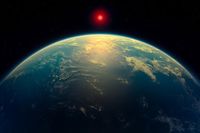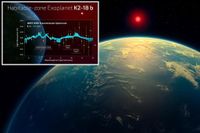Astronomers have discovered a major sign of life on the exoplanet K2-18b, a distant world located 124 light-years from Earth. This groundbreaking finding suggests the presence of dimethyl sulfide, a molecule typically associated with living organisms, in the planet's atmosphere. The study, published in the Astrophysical Journal on April 16, 2025, marks a significant milestone in the search for extraterrestrial life.
K2-18b, which is about eight times the size of Earth, is classified as a "Hycean planet"—a term coined by Dr. Nikku Madhusudhan of the University of Cambridge in 2021. These planets are characterized by liquid oceans and hydrogen-rich atmospheres, making them prime candidates for hosting life. Dr. Madhusudhan described the discovery as a "revolutionary moment," emphasizing the implications of finding such a life-signifying molecule.
The organic compound dimethyl sulfide is primarily produced by phytoplankton and certain bacteria on Earth, and it is prevalent over the oceans. During atmospheric measurements conducted by Madhusudhan's team using the James Webb Space Telescope, they confirmed the overwhelming presence of dimethyl sulfide on K2-18b, with levels measured at 1,000 times higher than those found on Earth.
"It is a shock to the system," Madhusudhan stated at a news conference on April 15, 2025. "We spent an enormous amount of time just trying to get rid of the signal." The strong signals from dimethyl sulfide were so pronounced that they complicated other tests the researchers were conducting.
In addition to dimethyl sulfide, the James Webb readings also indicated the presence of hydrogen, methane, and other carbon components, further supporting the notion that K2-18b could be a Hycean world. The planet was first discovered in 2015 by NASA’s Kepler mission, which identified its location in the "Goldilocks zone"—the region around a star where conditions are just right for liquid water to exist, a crucial ingredient for life as we know it.
"This is the strongest evidence yet there is possibly life out there," Madhusudhan told the BBC, expressing optimism about confirming these findings within one to two years. He added, "If we confirm that there is life on K2-18b, it should basically confirm that life is very common in the galaxy." The researchers believe that the presence of such a high concentration of dimethyl sulfide could indicate that K2-18b is teeming with life.
However, the scientific community is urging caution. Stephen Schmidt, a planetary scientist at Johns Hopkins University, remarked, "It’s not nothing. It’s a hint. But we cannot conclude it’s habitable yet." Similarly, Laura Kreidberg, an astronomer at the Max Planck Institute for Astronomy, stated, "I think this is one of those situations where extraordinary claims require extraordinary evidence. I'm not sure we're at the extraordinary evidence level yet."
Mans Holmberg, a researcher at the Space Telescope Science Institute, echoed these sentiments, emphasizing the need for further investigation. "For looking at things like this, it requires a dedicated community effort," he said. "We should be cautious. I want that to be front and center. Any claim of life on another planet requires a lot of justification, and I don’t think we’re there yet."
Despite the excitement surrounding the discovery, there remains an ongoing debate about the significance of the detected molecules and whether they are indeed indicative of life. Holmberg noted that it could either point to a new chemical process not previously observed or suggest the first signs of biological activity outside of Earth.
The implications of this research are profound. If confirmed, the existence of life on K2-18b could reshape our understanding of the universe and the prevalence of life beyond our planet. The discovery aligns with a growing body of evidence suggesting that life may exist in various forms throughout the galaxy.
As scientists continue to analyze the data and conduct further observations, the excitement surrounding K2-18b remains palpable. The potential for discovering life on another planet has captured the imagination of researchers and the public alike, driving home the importance of continued exploration and study of our universe.
In summary, the detection of dimethyl sulfide on K2-18b opens a new chapter in the quest for extraterrestrial life. While caution is warranted, the findings are undeniably intriguing and could lead to groundbreaking revelations about the nature of life beyond Earth.





